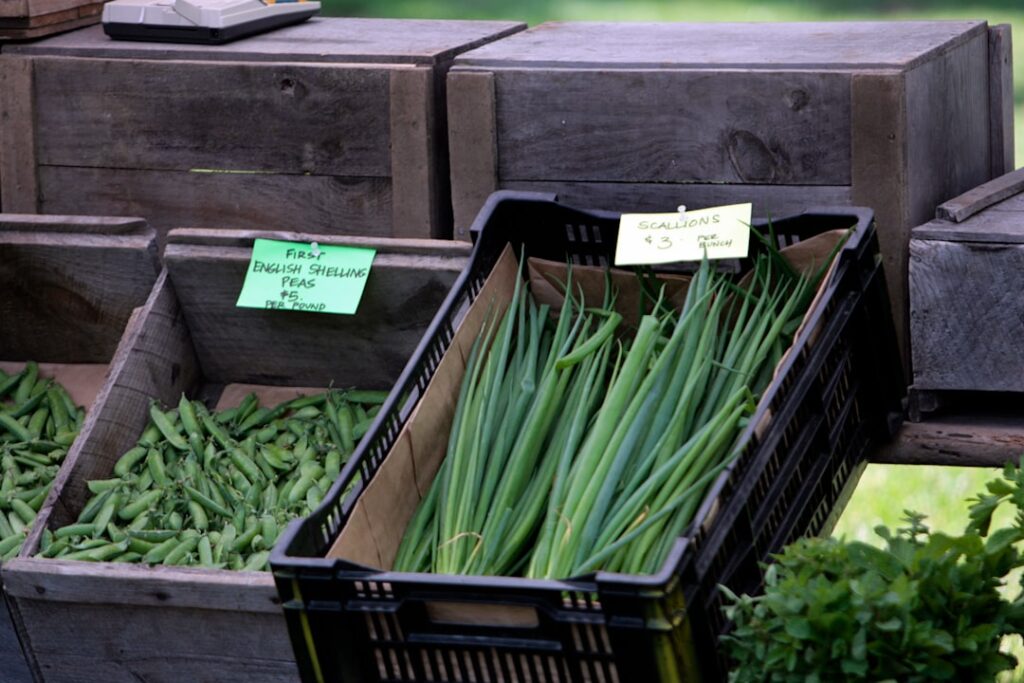Why Scallions Are the Unsung Heroes of Global Cuisine
Scallions are mild-flavored allium vegetables that belong to the onion family, featuring long green stalks and small white bulbs that deliver fresh, oniony flavor without overwhelming intensity. Also known as green onions, these versatile vegetables are harvested before bulb formation and offer both edible white and green parts.
Quick Scallion Facts:
- What they are: Young allium plants (Allium fistulosum or Allium cepa) harvested before bulb development
- Flavor: Mild, fresh onion taste – white parts are sharper, green tops are grassy and subtle
- Uses: Raw garnish, cooked in stir-fries, grilled whole, or blended into sauces
- Storage: Up to 1 week in refrigerator (jar with water) or 3 days (damp paper towel)
- Nutrition: Low calories (32 per 100g), high in vitamin K (173% daily value), vitamin C, and fiber
For culinary travelers seeking authentic dining experiences, scallions represent the perfect intersection of global accessibility and local flavor. From Korean pajeon pancakes to Mexican cebollitas, these humble alliums appear in traditional dishes across continents, making them essential knowledge for any food enthusiast.
Unlike their stronger onion cousins, scallions offer sustainable cooking versatility – you can use every part of the plant, regrow them from kitchen scraps, and find them fresh in markets worldwide. Their mild bite makes them ideal for both raw applications and cooking, bridging the gap between sharp onions and delicate herbs.
Whether you’re recreating street food findies from your travels or exploring local farmers markets in New York City, understanding scallions opens doors to countless authentic culinary experiences while supporting zero-waste cooking practices.
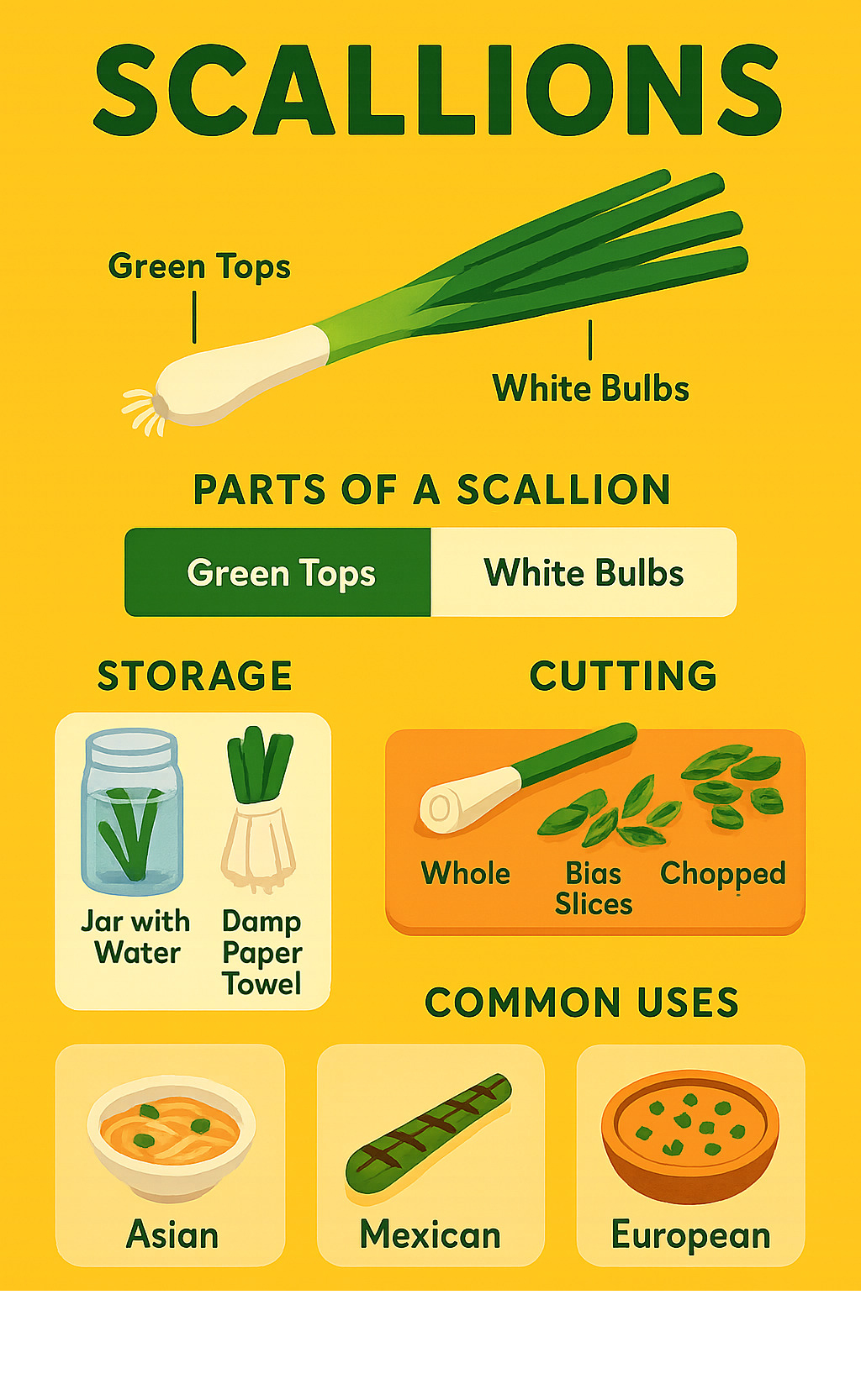
What Are Scallions? Botanical Identity & Look-Alikes
If you’ve ever stood in the produce aisle wondering whether you’re looking at scallions, green onions, or spring onions, you’re not alone. The world of mild alliums can feel like a botanical mystery, but once you understand the basics, everything clicks into place.
Scallions belong to the Allium genus – the same family that gives us onions, garlic, and leeks. Here’s where it gets interesting: what we call scallions actually includes two different species. Most commonly, you’ll find Allium fistulosum (the Welsh onion) and certain varieties of Allium cepa (regular onions) that are harvested before they develop full bulbs.
The key feature that makes a scallion a scallion is its hollow, tubular green leaves and the absence of a fully formed bulb. Think of them as the teenagers of the onion world – they haven’t quite grown up yet, which is exactly what makes them so versatile in the kitchen.
Allium fistulosum naturally stays slender and never forms large bulbs, making it perfect for continuous harvesting. Meanwhile, some scallions are simply baby Allium cepa plants pulled from the ground early in their development. Both types give you that mild, fresh onion flavor that works beautifully in everything from Asian stir-fries to Mexican salsas.
The naming confusion comes from centuries of culinary tradition. The word “scallion” traces back to the ancient city of Ascalon, traveling through Old French and Latin to reach our modern kitchens. Around the world, you’ll hear these same vegetables called green onions, spring onions, salad onions, bunching onions, or even Welsh onions – though these terms don’t always mean exactly the same thing.
Key differences between scallions and spring onions:
- Bulb development: Scallions have no bulb or just a tiny white base, while spring onions show small but visible bulb formation
- Flavor strength: Scallions taste mild and sweet, spring onions pack more onion punch
- Best cooking methods: Scallions shine in raw applications and quick cooking, spring onions handle grilling and roasting better
- Harvest timing: Scallions are picked before bulb formation, spring onions after small bulbs develop
Green onions vs scallions: the exact same allium
Here’s the simplest part of this whole botanical puzzle: green onions and scallions are exactly the same thing. There’s no difference whatsoever – it’s purely a matter of regional preference and grocery store labeling.
You might see both terms used in the same market, sometimes even for identical bunches of vegetables. This dual naming reflects America’s diverse culinary heritage, where European immigrants brought the term “scallion” while English speakers naturally gravitated toward the more descriptive “green onion.”
Whether you call them scallions or green onions, you’re getting the same mild, versatile allium that’s been enhancing dishes across cultures for thousands of years.
Scallions vs spring onions and chives: spot the differences
While scallions and green onions are identical twins, spring onions are more like their older siblings. Spring onions have had more time to mature and develop small but noticeable bulbs at their base. These bulbs give spring onions a stronger, more pronounced onion flavor that’s less suitable for sprinkling raw over your morning eggs.
The visual difference is obvious once you know what to look for. Scallions maintain a relatively uniform white shaft that doesn’t bulb significantly, while spring onions show clear bulb formation that can be white, purple, or red depending on the variety.
In the kitchen, spring onions hold up better to high-heat cooking methods like grilling and roasting because their firmer structure doesn’t break down as quickly. Scallions, with their tender texture, are perfect for quick sautéing, raw garnishes, and delicate applications.
Chives represent a completely different branch of the allium family tree. These Allium schoenoprasum plants have thin, grass-like leaves and deliver a more delicate onion flavor. Unlike scallions, chives don’t have substantial white portions suitable for cooking – they’re primarily used as a fresh garnish to add a gentle onion note to finished dishes.
Understanding these distinctions helps you steer farmers markets and grocery stores with confidence, whether you’re shopping in New York City or recreating international recipes that call for specific types of alliums.
Scallion Benefits & Nutrition Facts
When it comes to scallions, you’re getting incredible nutritional bang for your buck. These slender green beauties pack a surprising punch of vitamins and minerals while weighing in at just 32 calories per 100 grams. It’s like nature’s way of giving you a health boost without any guilt.
The real star of the show is vitamin K – and we’re talking about a showstopper here. A single 100-gram serving delivers a whopping 173% of your daily vitamin K needs. That’s more than most people get in an entire day! This powerhouse vitamin keeps your bones strong, helps your blood clot properly, and may even protect your brain as you age.
Vitamin C is another standout, providing 21% of your daily value in that same serving. Your immune system will thank you, and your skin will too – vitamin C is essential for collagen production and helps your body absorb iron from other foods you eat.
Here’s where things get really interesting: Scientific research on scallion health benefits shows that scallions contain sulfur compounds, particularly allicin, which may help keep your heart healthy by reducing cholesterol production. These beneficial compounds are released when you chop or bite into scallions – so that fresh, sharp bite you taste is actually your body getting a dose of natural medicine.
The fiber content might seem modest at 2.6 grams per 100 grams, but remember – you’re getting about 10% of your daily fiber needs in a virtually calorie-free package. This fiber helps keep your digestive system happy and your blood sugar stable.
Why scallions punch above their weight nutritionally
The nutrient density of scallions is honestly impressive when you consider how mild and unassuming they taste. They’re quietly delivering 997 IU of vitamin A per 100 grams – that’s 33% of your daily value right there. Your eyes and immune system are getting serious support from these green stalks.
Folate is another hidden gem in scallions. While it’s not as dramatic as the vitamin K content, it still contributes meaningfully to your daily needs. This B-vitamin is especially important if you’re pregnant, but everyone benefits from its role in cellular function and tissue growth.
The antioxidant compounds in scallions, including flavonoids and those sulfur compounds we mentioned, work like tiny bodyguards against inflammation. Laboratory studies have shown that extracts from allium vegetables can fight off certain bacteria and fungi, though scientists are still working to understand exactly how this translates to benefits in our bodies.
For the complete nutritional breakdown, check out the USDA Database entry – it’s fascinating to see how much nutrition is packed into these slender green stalks that we often just think of as garnish.
How to Buy, Store & Prep Scallions
Shopping for scallions is like hunting for culinary treasure – once you know what to look for, you’ll spot the best bunches from across the produce aisle. The secret lies in those bright green tops that should stand tall and proud, almost like they’re waving hello. Fresh scallions have that crisp, snappy quality that makes them feel alive in your hands.
The white portions tell their own story of freshness. They should feel firm and substantial, never squishy or slimy to the touch. When you find scallions at farmers markets, don’t be put off by a little soil clinging to the roots – that’s actually your green flag for recent harvest. The earth acts like nature’s own preservation system, keeping moisture locked in where it belongs.
Skip any bunches with yellowing tips or brown spots, and trust your nose. Fresh scallions should smell clean and mildly oniony, not sharp or overpowering. If they’re giving off strong odors, they’re past their prime and will disappoint in your cooking.
Here’s a pro tip from our kitchen trips: buy a little extra. Scallions are incredibly forgiving to store, and you can actually regrow them from scraps. It’s like getting a bonus plant with your purchase.
Storing scallions for maximum crunch
The difference between crisp, vibrant scallions and sad, wilted ones often comes down to storage technique. We’ve tested countless methods, and two approaches consistently deliver restaurant-quality results at home.
For quick use within three days, the damp paper towel method works beautifully. Wrap your cleaned scallions in a slightly moist paper towel – not soaking wet, just pleasantly damp – then tuck them into a plastic bag in your crisper drawer. This creates the perfect humidity bubble that keeps them fresh without encouraging rot.
When you need longer storage, treat your scallions like fresh flowers. Trim the roots and stand them upright in a jar with an inch or two of water. Cover the green tops loosely with a plastic bag and refrigerate. Change the water every few days to keep things fresh.
The jar method has a delightful surprise: your scallions will often keep growing slowly in the fridge, giving you fresh green shoots to snip. It’s like having a tiny garden in your refrigerator.
Prepping scallions: white vs green parts
Understanding the personality of each part of the scallion transforms how you cook with them. The white and light green sections are the bold, assertive parts – they pack more onion punch and hold their shape beautifully when heated. These are your workhorses for building flavor bases and standing up to sautéing.
Start by trimming the root end as close to the base as possible, then slice these white portions into rounds or strips. They caramelize gorgeously when cooked, developing a sweet depth that makes dishes sing.
The dark green tops are the gentle souls of the scallion world. They’re tender, grassy, and perfect for finishing touches. These delicate greens shine when used raw as garnishes, stirred into completed dishes, or tossed fresh into salads and salsas.
For the most professional results, separate the white and green portions before slicing. Cut on the bias – at an angle – for beautiful presentation and maximum surface area that releases more flavor into your cooking. This simple technique makes even the humblest home dish look restaurant-worthy.
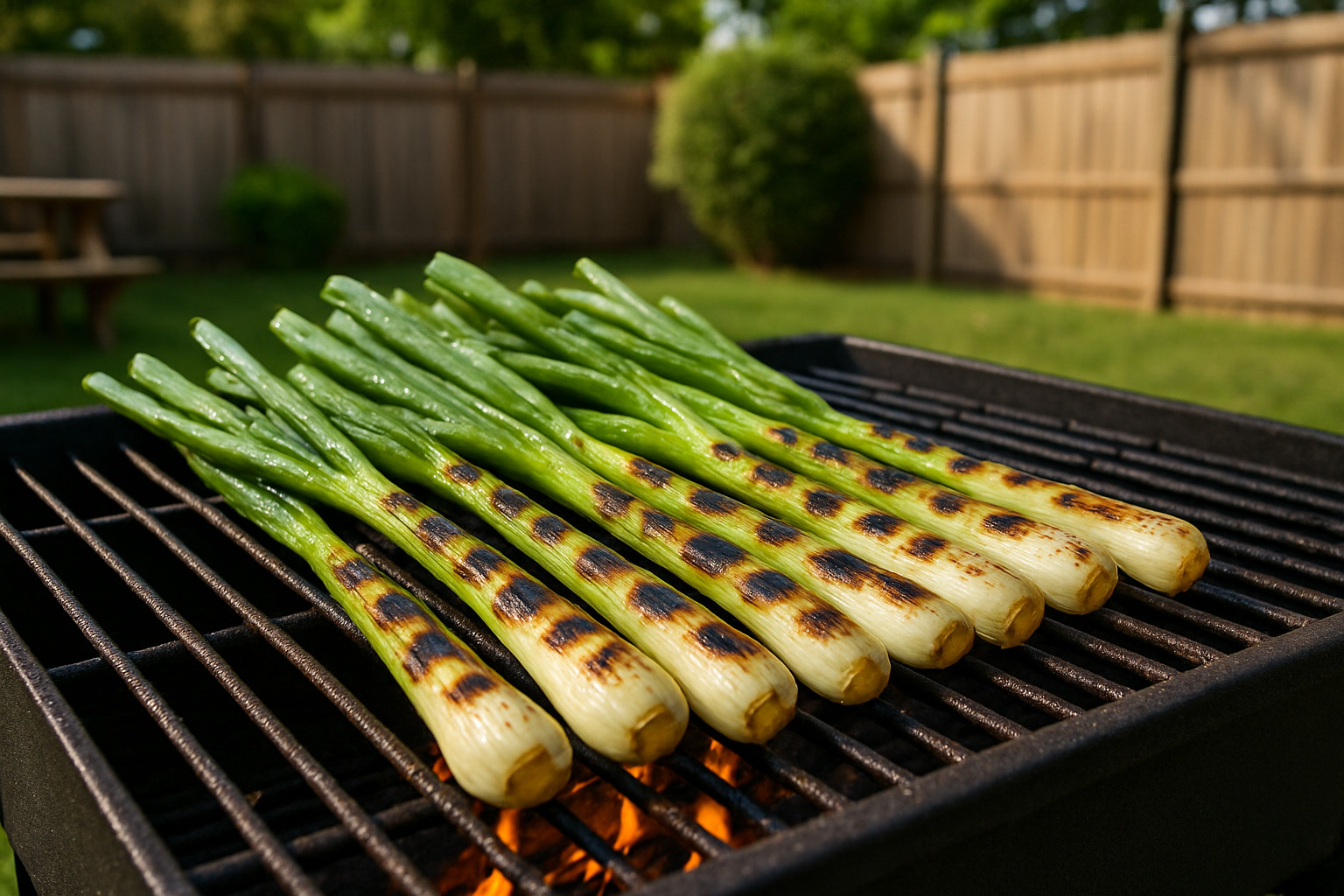
Cooking with Scallions Around the World
Scallions appear in traditional cuisines across the globe, often forming the foundation of regional flavor profiles. In Chinese cooking, they’re part of the “holy trinity” alongside ginger and garlic – a combination that appears in countless stir-fries, sauces, and marinades.
Korean cuisine showcases scallions prominently in pajeon (scallion pancakes), where they’re mixed into a batter and pan-fried until crispy. These savory pancakes often include seafood and are served with a soy-based dipping sauce, representing comfort food at its finest.
The Catalan tradition of calçotada involves grilling special varieties of scallions called calçots over open flames, then dipping them in romesco or salvitxada sauce. This communal cooking and eating experience typically happens in late winter and early spring.
Mexican cuisine features cebollitas – grilled scallions served alongside cheese, rice, and lime juice as a simple but flavorful side dish. The grilling process caramelizes the natural sugars and mellows the onion bite.
In Ireland, scallions are essential to champ, a traditional dish of mashed potatoes mixed with chopped scallions and butter. This comfort food demonstrates how simple ingredients can create deeply satisfying flavors.
Even Jewish Passover traditions incorporate scallions, where Afghan and Persian Jewish communities use them in a symbolic whipping ritual to commemorate historical hardships.
Flavor profile of scallions compared to other onions
Scallions offer a unique position in the allium flavor spectrum. They provide genuine onion taste without the sharp bite that can overwhelm delicate dishes or raw preparations. The white portions deliver more intensity, while the green tops contribute a fresh, almost herbal quality.
When cooked, scallions develop sweetness quickly due to their high water content and natural sugars. They caramelize beautifully when sautéed but don’t hold their shape as well as firmer onions during long cooking processes.
The mild nature of scallions makes them excellent for layering flavors. They can provide an onion base without competing with other ingredients, making them ideal for dishes where you want allium presence without dominance.
Raw scallions add crunch and brightness to dishes, cutting through rich or heavy flavors. This makes them particularly valuable in cuisines that balance rich proteins or sauces with fresh, crisp elements.
Quick recipes featuring scallions
Scallion oil represents one of the most versatile condiments you can make. Heat neutral oil gently, add chopped scallions, and cook until fragrant and lightly golden. This aromatic oil improves rice noodles, dumplings, and countless other dishes.
For scallion pancakes, mix chopped scallions into a simple batter of flour, water, and egg. Pan-fry until golden and crispy, then serve with soy sauce mixed with rice vinegar and a touch of sesame oil.
A quick scallion-ginger sauce combines minced scallions and ginger with soy sauce, rice vinegar, and a pinch of sugar. This bright condiment works beautifully with steamed fish, grilled meats, or as a dipping sauce for dumplings.
Grilled scallions require minimal preparation – simply brush whole scallions with olive oil, season with salt and pepper, and grill until charred and tender. They make an excellent side dish that pairs well with broccolini and other grilled vegetables.
Growing Scallions at Home
Growing scallions at home is remarkably simple and rewarding, whether you start from seeds or kitchen scraps. Seeds typically germinate in 7-14 days under proper conditions, while regrown scallions from cut roots can show new growth within a week.
For seed starting, scallions prefer well-drained soil with a pH between 6.2 and 6.8. They tolerate a wide range of growing conditions but perform best in full sun to partial shade. The shallow root system means they don’t require deep containers, making them perfect for apartment gardening or small spaces.
Container gardens work exceptionally well for scallions. Use pots at least 6 inches deep with drainage holes, and space plants about 1 inch apart. They’re cold-hardy down to -10°F (-33°C) once established, making them suitable for year-round growing in many climates.
Indoor windowsill growing is entirely feasible, especially during winter months. Scallions need only a few hours of sunlight daily and can tolerate lower light conditions better than many vegetables.
Succession sowing every 3-4 weeks ensures a continuous harvest. Plant new seeds while harvesting mature plants to maintain a steady supply of fresh scallions.
The typical harvest window is 8-12 weeks from seed, though you can begin harvesting green tops earlier for a milder flavor. Harvest by cutting the largest stems first, leaving smaller ones to continue growing.
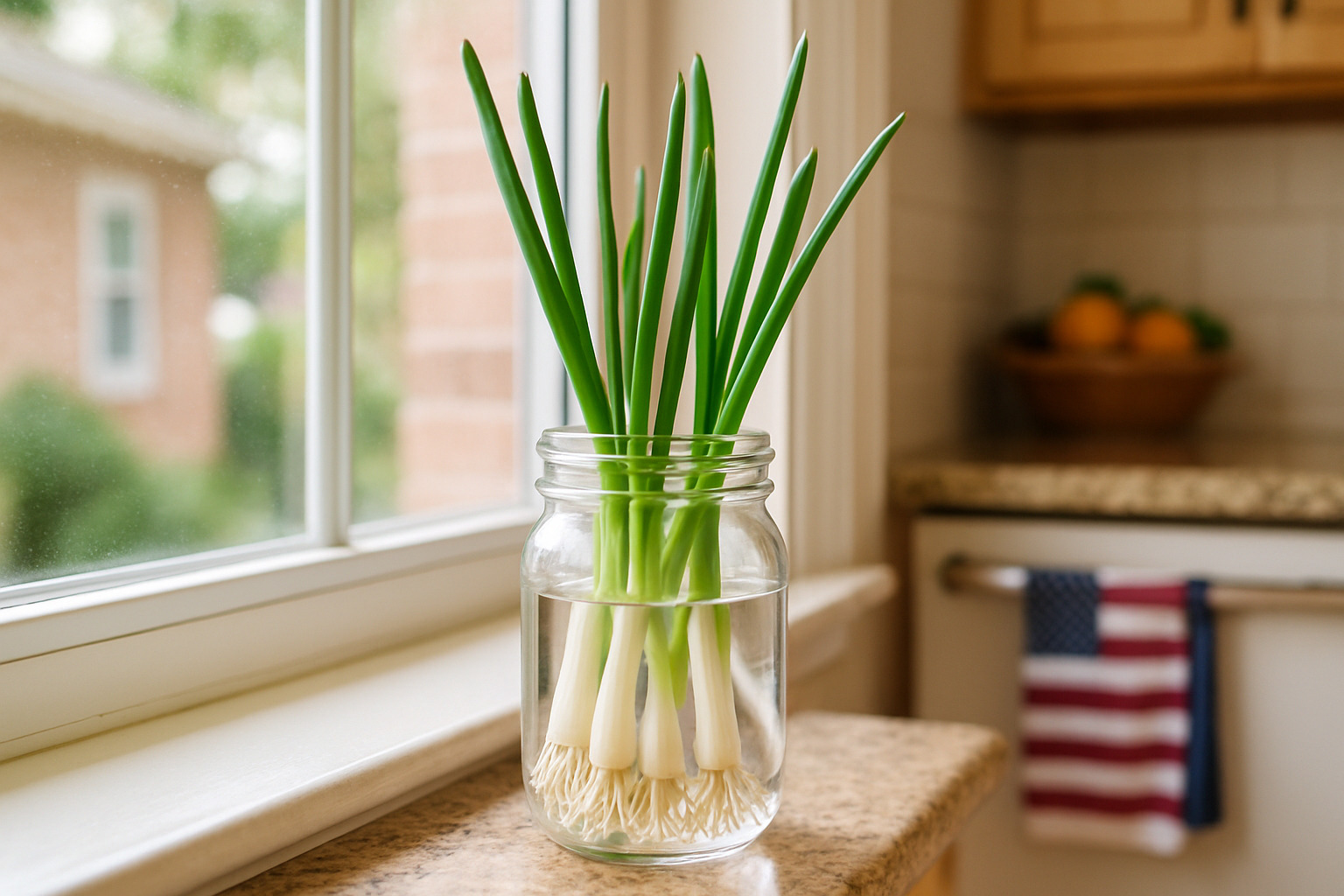
From scraps to endless scallions: step-by-step
Regrowing scallions from kitchen scraps represents the ultimate in sustainable cooking. Start with scallions that still have their white root ends intact – even if the roots have been trimmed, small root nodes can often regenerate.
Cut the scallions about 2 inches from the root end, using the green portions for cooking. Place these root ends in a jar with enough water to cover the roots but not submerge the entire white portion.
Position the jar on a sunny windowsill and change the water every 2-3 days to prevent bacterial growth. New green growth typically appears within 5-7 days, and you can begin harvesting again in 7-10 days.
For longer-term growing, transplant the regenerated scallions to soil once they’ve developed strong root systems. Space them about 2 inches apart in containers or garden beds with good drainage.
Adding organic compost to the soil provides gentle nutrition that supports continued growth without overwhelming these relatively light feeders. Well-composted material also improves soil structure and water retention.
Common pests include aphids and slugs, but these are generally manageable with organic methods like companion planting or physical barriers. The strong scallion aroma actually helps deter many garden pests when grown alongside other vegetables.
Learn About Scallions – Burpee provides additional growing tips and variety recommendations for home gardeners.
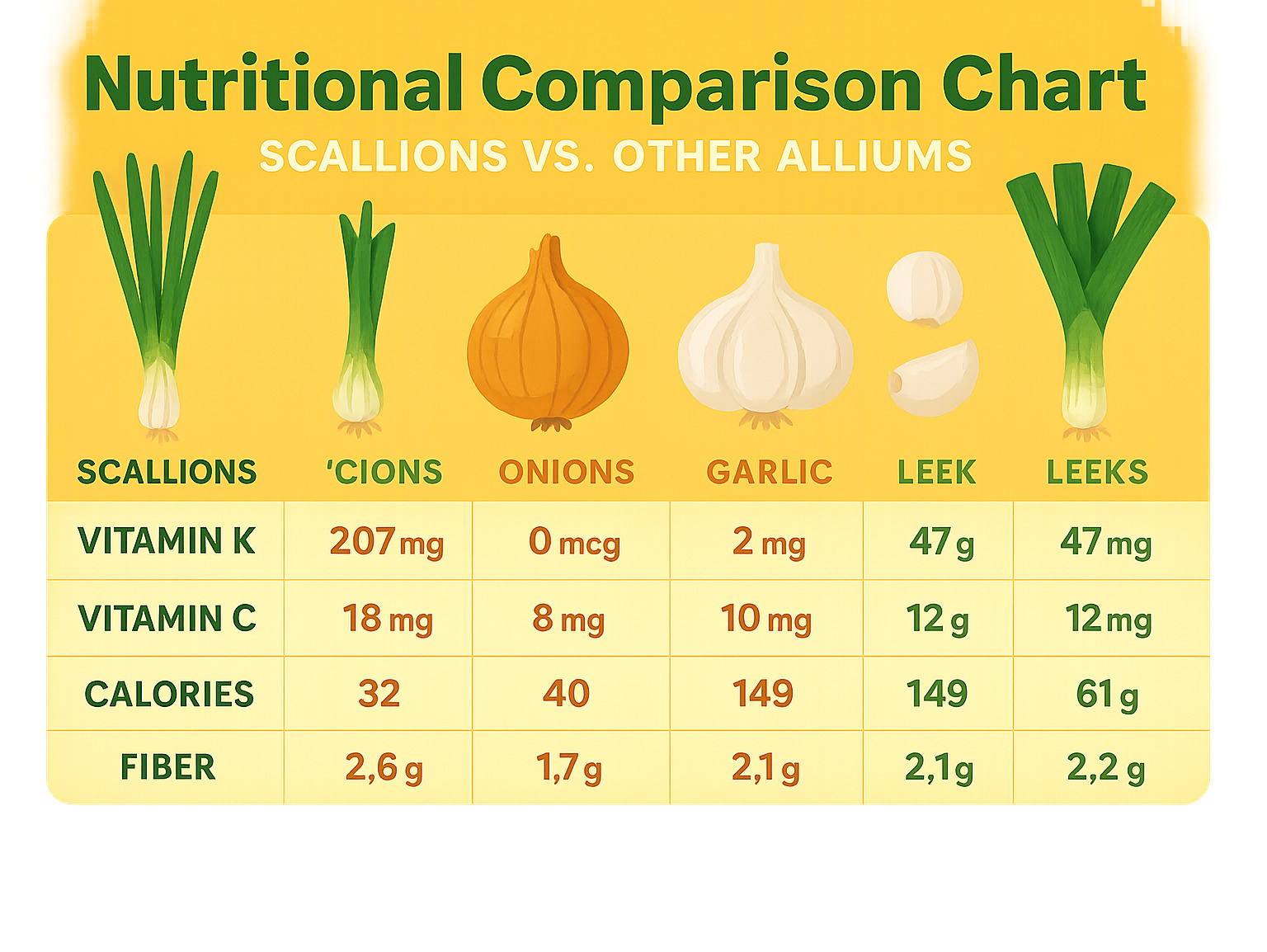
Frequently Asked Questions about Scallions
Are scallions and spring onions interchangeable in recipes?
When you’re standing in the produce aisle wondering if you can swap one for the other, the answer is usually yes – but with a few important caveats that can make or break your dish.
Scallions and spring onions work beautifully together in most cooked dishes. Toss them into stir-fries, soups, or grilled vegetable medleys and you’ll barely notice the difference. The heat mellows both vegetables, bringing their flavors closer together.
Where things get tricky is with raw applications. Spring onions pack a stronger punch that can overwhelm delicate dishes designed for scallions’ gentle bite. If your recipe calls for raw scallions as a garnish or in a fresh salsa, stick with the original ingredient for the best results.
Here’s a helpful trick: if you only have spring onions but need that milder scallion flavor, use more of the green tops and less of the white bulb portion. The reverse works too – when substituting scallions for spring onions in heartier dishes, you might want to use a bit more to achieve the same flavor impact.
Which parts of scallions are edible?
The wonderful thing about scallions is that you can eat every single part – from the white root end all the way up to those dark green tips. It’s like getting multiple ingredients in one vegetable!
The white and light green sections are your flavor powerhouses. They deliver that characteristic onion taste and hold up beautifully when cooked. Think of these as your cooking workhorses – perfect for sautéing as a base for soups or adding early to stir-fries.
The dark green tops are entirely different creatures. They’re milder, almost herbal, and shine brightest when used fresh. Sprinkle them over finished dishes, fold them into salads, or stir them into sauces at the last minute for a pop of color and gentle onion flavor.
Even those roots at the bottom are technically edible, though most cooks trim them off for aesthetic reasons. Some creative home cooks save the tougher outer green layers for making homemade stocks – they add great flavor without any textural concerns.
Can scallions trigger onion allergies?
If you’re dealing with onion allergies or sensitivities, scallions require the same caution as their stronger allium cousins. They contain those same sulfur compounds that cause reactions, just typically in lower concentrations.
The good news? Many people with mild onion sensitivities find scallions more tolerable, especially when cooked. Heat breaks down some of those irritating compounds, so you might be able to enjoy cooked scallions in dishes even if raw onions cause problems.
However, if you have a severe allium allergy, don’t take chances. Skip the scallions entirely unless your healthcare provider specifically says they’re okay for you.
Watch for the usual suspects when it comes to symptoms: digestive upset, skin irritation, or breathing issues. If scallions cause any problems, trust your body and avoid them. There are plenty of other ways to add fresh flavor to your cooking trips.
Conclusion
Scallions have quietly earned their place as one of the most valuable ingredients in any kitchen, bridging the gap between simple home cooking and sophisticated global cuisine. These unassuming green stalks carry the power to transform everyday meals into something special, whether you’re making a quick weeknight dinner or recreating that amazing dish you finded during your travels.
What makes scallions truly remarkable is how they connect us to food traditions around the world. From Korean street vendors crafting crispy pajeon to Mexican grills sizzling with cebollitas, these mild alliums appear in countless cultures because they simply work. They add depth without overwhelming, provide crunch without toughness, and offer that perfect onion flavor that plays well with almost everything.
The sustainability story of scallions feels especially relevant today. When we’re all trying to waste less and grow more of our own food, these little green heroes deliver on both fronts. You can literally eat every part of the plant, regrow them endlessly from kitchen scraps, and watch them thrive in the smallest spaces. It’s like having a renewable flavor factory right on your windowsill.
For anyone passionate about authentic dining experiences, mastering scallions opens up a whole new level of cooking confidence. Suddenly, those complex-sounding international recipes become approachable. You start noticing how restaurants use them, appreciating the subtle ways they improve dishes, and maybe even impressing your friends with your newfound knowledge.
The beauty of scallions lies in their democratic nature – they’re accessible to everyone, from apartment dwellers with tiny kitchens to suburban gardeners with sprawling yards. They don’t demand expensive equipment or exotic techniques. Just a sharp knife, some basic storage know-how, and the willingness to experiment.
At The Dining Destination, we’ve found that the best culinary trips often start with understanding simple ingredients like scallions. They represent everything we love about food exploration – the findy of new flavors, the connection to different cultures, and the satisfaction of creating something delicious with your own hands.
Ready to put your scallion knowledge to work? Check out our Easy Dinner Ideas for inspiration on incorporating these versatile alliums into your next culinary trip.

